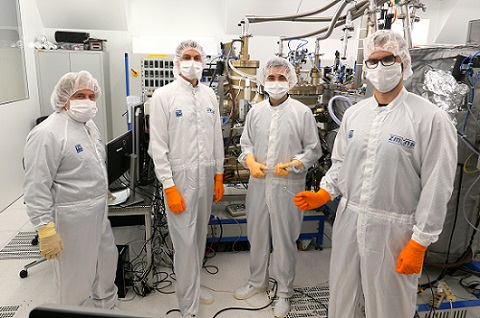VIENNA, Nov. 24, 2020 — Research efforts from Vienna University of Technology, in collaboration with Harvard University, have led to the development of a laser method that increases the practicality and usability of mid-infrared pulsed lasing.
Infrared lasers capable of generating short and intense pulses are desirable for applications such as molecular detection, though they have historically been difficult to manufacture. The new method doesn’t require large experimental setups and can be easily miniaturized.

From left, Gottfried Strasser, Benedikt Schwarz, Johannes Hillbrand, and Nikola Opacak. Courtesy of TU Wien.
The researchers first generated laser light in the mid-infrared range using tailor-made quantum cascade lasers (QCLs), manufactured in the Nano-Center of TU-Wien, said Johannes Hillbrand of the Institute of Solid State Electronics at TU Vienna, first author of the study describing the technology. Ordinary lasers’ particular light wavelengths depend on the atoms composing the material. In QCLs, however, tiny structures in the nanometer range can be designed and manipulated to adjust the wavelength of light.
“Our quantum cascade lasers do not just deliver a single color of light, but a whole range of different frequencies,” said Benedikt Schwarz, the assistant professor at Vienna University of Technology who led the research work. “These frequencies are arranged very regularly, always with the same distance in between, like the teeth of a comb. Therefore, such a spectrum is called a frequency comb.”
Frequencies are not the only deciding factor. Phase is also a consideration.
“You can compare this to two pendulums connected by a rubber band,” Hillbrand said. “They can either swing back and forth, exactly in parallel, or opposite to each other, so that they swing toward each other or away from each other. And these two vibration modes have slightly different frequencies.”
In laser light, individual lightwaves of the frequency comb can oscillate in sync and then superimpose one another and generate short, intense laser pulses. Their oscillations can be staggered, too, in which case light with an almost continuous intensity, not pulses, is created.
“In quantum cascade lasers, it has previously been difficult to switch back and forth between these two variants,” Hillbrand said. “However, we have built a tiny modulator into our quantum cascade laser, which the lightwaves pass by again and again.”
In the new system, an alternating electrical voltage is applied to the modulator. Depending on the frequency and strength of the voltage, different light oscillations can be excited.
“If you drive this modulator at exactly the right frequency, you can achieve that the different frequencies of our frequency comb all oscillate at exactly in sync,” Schwarz said. “This makes it possible to combine these frequencies into short, intense laser pulses — more than 12 billion times per second.”
Schwarz emphasized that the technology is additionally advantageous because it can be miniaturized.
“One could use it to build compact measuring instruments that use these special laser beams to search for very specific molecules in a gas sample, for example,” he said. “Thanks to the high light intensity of the laser pulses, measurements that require two photons at the same time are also possible.”
The research was published in Nature Communications (www.doi.org/10.1038/s41467-020-19592-1).